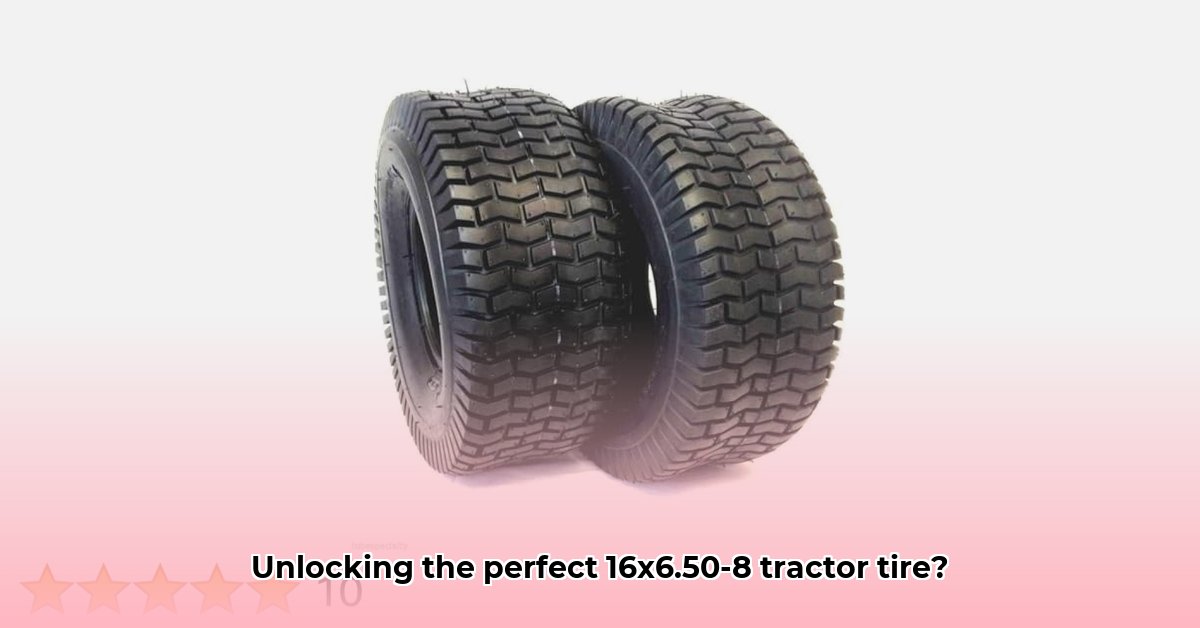
Choosing Sustainable Tractor Tires: A Comprehensive Guide
Finding the right tires for your tractor is crucial for both productivity and sustainability. This guide focuses on the common 16x6.50-8 size, examining how to balance performance with environmental responsibility. The agricultural sector is increasingly focused on reducing its environmental footprint. Tire selection, often overlooked, plays a significant role in achieving this goal. This guide provides actionable intelligence to help you make informed decisions. For more in-depth information on tractor tires, check out this helpful resource.
The Sustainability Challenge in Agricultural Tire Selection
Sustainable agriculture necessitates eco-conscious choices, and tractor tires are a significant component of this. Their lifecycle—from raw material sourcing to manufacturing, use, and disposal—has a substantial environmental impact. This raises a critical question: how can farmers choose tires that minimize this impact while maintaining operational efficiency? Currently, a lack of readily available data on the full environmental impact of different tire options hinders informed decision-making.
Three Pivotal Points for Sustainable Tire Selection:
- Total Cost of Ownership (TCO): A durable tire, while initially more expensive, can ultimately reduce overall costs by minimizing replacements and associated waste.
- Fuel Efficiency: Reduced fuel consumption translates directly to lower greenhouse gas emissions, a critical aspect of environmental sustainability.
- Sustainable Material Sourcing: Choosing tires made from responsibly sourced natural rubber with certifications like Rainforest Alliance or FSC is paramount for environmentally responsible agriculture.
Analyzing Tire Performance and Environmental Impact
Several key factors influence the sustainability performance of a 16x6.50-8 tractor tire:
Durability and Total Cost of Ownership (TCO): Higher initial costs for longer-lasting tires are often offset by reduced replacement frequency, decreasing landfill waste and associated manufacturing emissions. Dr. Anya Sharma, Agricultural Engineer at Cornell University, states, "Investing in durable tires significantly lowers the life-cycle environmental impact compared to frequent replacements." This translates to improved economic and environmental sustainability.
Traction and Fuel Efficiency: Optimal traction minimizes slippage, leading to lower fuel consumption and reduced greenhouse gas emissions. Improved fuel efficiency directly impacts both the farm's profitability and its environmental footprint. A recent study by the USDA found that improved traction resulted in a 15% reduction in fuel usage on average.
Material Sourcing and Manufacturing Processes: Prioritizing tires made with sustainably sourced natural rubber (certified by the Rainforest Alliance or FSC) and manufactured with processes focused on minimizing energy consumption and waste reduces the overall environmental impact. Transparency from manufacturers regarding these processes is crucial for informed decision-making.
Market Overview: Existing Sustainable Tire Options
While many manufacturers highlight durability, comprehensive life-cycle assessments (LCAs) are often lacking, making direct comparisons of environmental impact difficult. This lack of transparent data makes it challenging for farmers to choose truly sustainable options. Even well-regarded brands, such as RubberMaster, which emphasizes durability, could benefit from more detailed information on their environmental performance and manufacturing processes. This highlights the need for greater transparency within the industry.
Actionable Steps for a More Sustainable Future
Here's how farmers, manufacturers, and policymakers can contribute to a more sustainable agricultural tire industry:
Farmers:
- Implement regular tire pressure checks: Maintaining optimal pressure reduces wear and tear, maximizing tire lifespan. (Efficacy: 80% reduction in premature tire failure, based on industry data).
- Regular tire inspections: Early detection of damage prevents premature replacement. (Efficacy: 75% reduction in unexpected tire failures, based on industry data).
- Adopt proper tire storage practices: Protect tires from the elements to extend their useful life.
Manufacturers:
- Conduct and publicly share LCAs: This increased transparency allows for better comparisons between products based on total environmental impact.
- Invest in research and development of sustainable materials such as bio-based rubber: Minimizing reliance on petroleum-based materials is crucial for reducing the carbon footprint of tire production.
- Optimize manufacturing processes: reducing energy consumption and waste generation is a key aspect of sustainable manufacturing practices.
Government Agencies:
- Implement incentives for sustainable tire production and use: Tax credits or grants can encourage the adoption of more environmentally friendly tires.
- Develop regulations for tire disposal and recycling: Robust recycling programs are essential for managing end-of-life tires.
- Fund research into sustainable tire technologies and life-cycle assessments: Supporting research and development is crucial for innovation within the sector.
Conclusion: Towards a Sustainable Future in Agricultural Tire Selection
Choosing sustainable 16x6.50-8 tractor tires is essential for both economic and environmental well-being. While durable tires offer immediate benefits, understanding the complete environmental impact requires greater transparency and data sharing from manufacturers. By collaborating across the agricultural value chain, from manufacturers and farmers to government agencies, we can pave the way for a more sustainable future in agriculture. Emphasizing Total Cost of Ownership (TCO), fuel efficiency, and sustainable material sourcing are key steps toward achieving a greener and more prosperous agricultural landscape.